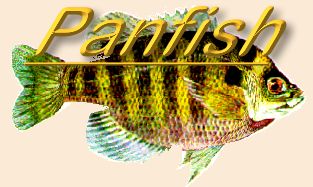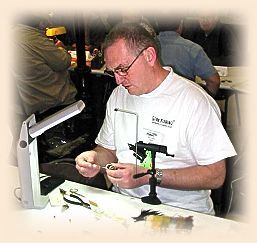|
It is the Saturday before Thanksgiving. My wife has a
meeting that she needs to be at. I have my schedule
cleared of any activities. That means at mid morning
I would head to a pond.
Two reasons for going at mid morning. First the hunter
will be out of the field. Second the temperature will
be up a little, making it a little more comfortable to
fish.
I left at about 9:15 am. It takes about ten minutes to get
to the pond. I see several vehicles with hunter leaving
fields and heading home for a while. I get to the pond
and get everything set up to go. There is some wind today,
about 20 mph, out of the southwest.
I have three fly rods with me today. All three are six
wts. These are a little easier to cast in the wind. Two
with floating lines and one with a full sinking line on
it. I have a yellow boa yarn leech on one rod to act as
an attractor. I have a black nymph pattern on the second
floating line. The sinking line has a black leech pattern
on it.
I had a chance to place some brush on this pond while it
was being built. There are three piles of limbs. All are
about 30 feet long, eight feet wide and about six feet
tall. They are made from branches cut off of hardwood,
deciduous trees. I have a few builder friends that will
stick some wire into any little pile of excess concrete
that they have, following a concrete pour. That is what
these limbs were anchored with. They all are in about 10
to 12 feet of water. Each pile has about a dozen limbs
in it with several other small branches interspersed
through those.
I do not get into this pond very often. You have to wait
until the crops are out to get to it. There is a big gully
in the pasture where this pond is located and that keeps you
from driving in that way. The land owner has had some trouble
on this land and keeps the gate to the pasture locked.
So I wait until the crops are out and then go into
the pond from the other side.
I got out on the pond and got anchored so I could cast
over one of the brush piles. I know that there will be
fish around these brush piles. It is just a matter of
finding the fly they want and the depth they want it at.
Thirty minutes of casting told me that they did not
want any of the flies that I was using. It was time
to change tactics some. I went to the full sinking
line and cast it so it would be near the brush pile.
I let it go down for along time and then slowly started
to retrieve the fly. I would pull the fly and inch or
two and then let it set a couple of seconds.
I did this until the line was nearly back to the canoe
when I tired to raise it to cast again. That is when I
figured out that I had a fish on the line. It was a nice
sized bluegill that had taken the fly. I never felt this
fish hit the fly. I did not feel any resistance on the line.
I did this five more times. I caught two more fish and
lost three more near the canoe. All of the fish were
hooked in the lip. The ones I lost were barely lip hooked
when I saw them. This is what I surmised was happening:
the fish were taking the fly and then following the
pressure as I retrieved the fly. I was not feeling this
happen, so it was time to change tactics a little.
I would retrieve the fly a few feet and then make a
large strip to see if there was a fish on the line.
The large strip would be a hook set if a fish was
there. If not then, it was time to let the fly cover
some more water. I alternated sides on the brush pile
each time I cast.
I found that about 40% of the time when I did the large
line strip I had a fish on the line. Many of them were
crappie, but I only got two to the canoe. The rest flipped
off when I got them near the canoe, much to my regret. The
bluegills were taking the fly the same way, but I managed
to get more of them into the boat. I landed less than half
the number of fish that I hooked.
I also got a few good sized bass in the mix. I lost a
couple of flies, because whatever hit the fly went into
the brush and broke me off. To me that is just part of
the experience, when you fish that close to a brush pile.
Also, if I don't lose a couple of flies, I am not fishing
close enough to the brush to catch the fish.
The wind came up and that made it hard to cast. Also with
the wind blowing across my hands after handling the line
and the fish, they were getting cold. It was time to go
so I could get everything loaded back onto and into the
truck.
I found that I had brought 26 bluegills and two crappie
home. I had checked the water and it was 40 degrees. This
made for some good eating fillets.
If you have words of advice on how to feel a strike on
a full sinking line, please let me know.
Hope you can get out on the water. ~
Rick
|



